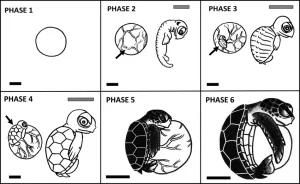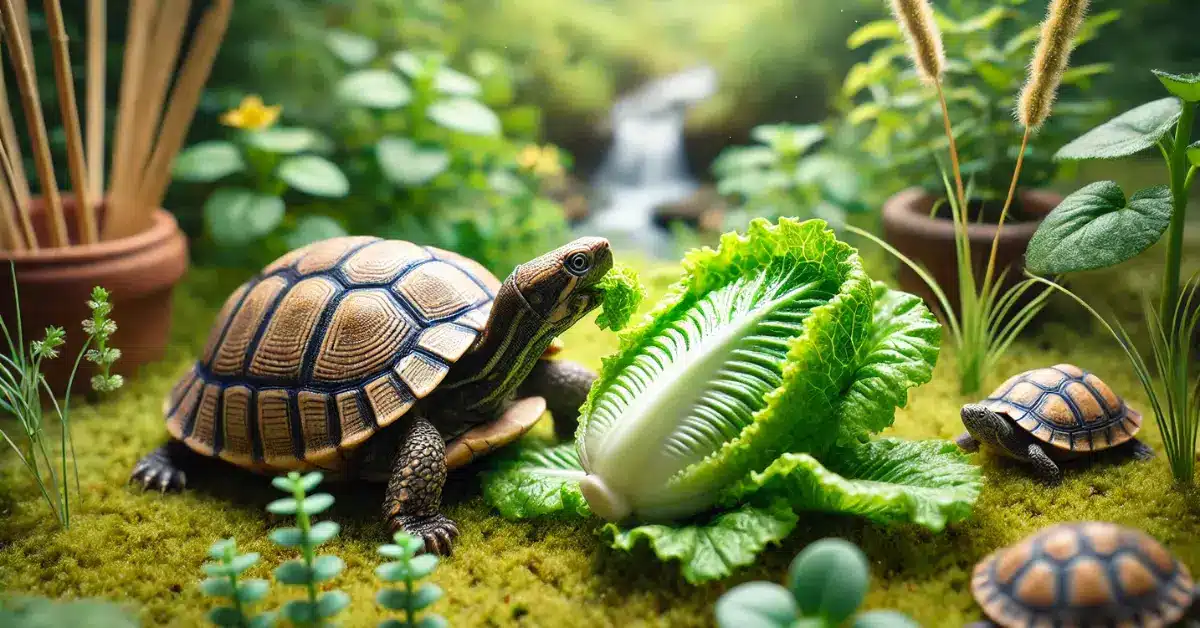Welcome to our journey into the world of turtles! Have you ever asked, “How many eggs can a turtle lay?” Join us on Theturtles.info as we explore how turtles from oceans, lakes, and lands lay their eggs and what challenges they face along the way.
Table of Contents
ToggleTurtle Egg-Laying Basics
Turtles are amazing creatures, and one of the coolest things about them is how they lay eggs. Each type of turtle lays eggs a bit differently, but it’s always an important part of their life. Let’s dive into the basics to see how they do it!
The Nesting Process
When it’s time to lay eggs, female turtles look for a good spot that’s safe from dangers like predators. They need a place that’s just right for the eggs to grow properly. Once she finds the perfect spot, she digs a nest using her back legs. She makes sure the nest is in sandy or soft soil. After laying her eggs, she covers them up with sand or dirt to keep them safe from bad weather and animals that might eat them. Then, she heads back to the water. The baby turtles will have to take care of themselves once they hatch.
Factors Influencing Egg Production
How many eggs a turtle can lay and whether they will hatch depend on a few things. Let’s look at them:
Species:
Different types of turtles lay different numbers of eggs. For example, big sea turtles like the leatherback might lay up to 100 eggs at once, while smaller turtles in freshwater might lay less than 10. The kind of turtle affects not just how many eggs they lay but also how big the eggs are and how long they take to hatch.
Age and Size:
Usually, older and bigger turtles lay more eggs than younger or smaller ones. As turtles get older, they get better at making and laying eggs, which helps make sure more baby turtles can hatch.
Environmental Conditions:
Where a turtle lives affects how many eggs she lays too. Things like the weather, how wet or dry it is, and how safe the nesting spot is all make a difference. Warm places usually mean more eggs, while cold or changing environments might mean fewer eggs.
Egg-Laying Capacity Across Different Turtle Types
Turtles come in all shapes and sizes, and so do their eggs! Depending on where they live— in the sea, in freshwater, or on land—turtles have different ways of laying eggs. Let’s explore how many eggs different types of turtles can lay.
Sea Turtles: Nature’s Prolific Layers
Sea turtles are known for laying a lot of eggs. Here’s how three types of sea turtles stack up:
Loggerhead Turtles
Loggerhead turtles are big and can lay between 100 to 126 eggs at a time. They like to nest on beaches, digging deep to make sure their eggs are safe.
Green Sea Turtles
Green sea turtles are also generous when it comes to egg-laying. They usually lay around 115 eggs in one nest. These turtles are special because they can lay eggs multiple times in a season!
Leatherback Turtles
Leatherback turtles take the cake when it comes to egg numbers. They can lay up to 110 eggs in one go, but not all of them are real—some are just there to protect the real eggs from harm.
Freshwater Turtles: Modest but Mighty
Freshwater turtles may not lay as many eggs, but they are still impressive.
Red-eared Sliders
Red-eared sliders lay around 10 to 30 eggs. They choose soft, sandy spots near water to build their nests.
Painted Turtles
Painted turtles like to lay their eggs in sunny spots. They usually lay about 4 to 15 eggs each time they nest.
Snapping Turtles
Snapping turtles lay more eggs than some other freshwater turtles—about 20 to 40 eggs. They look for muddy areas to hide their eggs from predators.
Land-Dwelling Turtles: The Tortoise Tale
Tortoises, which live on land, have their unique egg-laying habits.
Box Turtles
Box turtles lay fewer eggs, usually around 3 to 6 per nest. They prefer leafy areas or loose soil to lay their eggs.
Desert Tortoises
Desert tortoises are built for tough environments. They lay about 4 to 8 eggs, usually in sandy areas where the eggs can stay warm and safe.
Turtle Egg Development Process

Once a turtle lays her eggs, the next stage in their life cycle begins. This stage is crucial and includes everything from how long the eggs need to sit before they hatch to what dangers they might face along the way. Let’s look at the incredible journey from nest to hatchling.
Read more: What Do Turtle Eggs Look Like?
The Incredible Journey: From Nest to Hatchling
Incubation Period
The incubation period is the time it takes for the eggs to hatch. This can vary a lot depending on the type of turtle and the temperature of the environment. For example, sea turtle eggs usually take about 60 days to hatch, but if it’s hotter, they might hatch a bit faster. The temperature not only affects how quickly the eggs hatch but can also determine the sex of the hatchlings. Warmer sand usually means more female turtles hatch!
Hatching Success Rates
Not all eggs that turtles lay will hatch. The success rate can depend on many factors. If the eggs are laid in a good, safe spot and the weather is stable, most of them might hatch. However, if there are a lot of storms, floods, or other problems, fewer eggs will make it. For instance, green sea turtles can have hatching success rates as high as 80%, but if conditions aren’t right, fewer than half of their eggs might hatch.
Predators and Environmental Threats
Eggs and hatchlings face many dangers. Predators like birds, raccoons, and even crabs can dig up and eat the eggs. Once the turtles hatch, they must make a risky journey from the nest to the water, dodging more predators along the way. Besides animals, human activities like coastal development and pollution also threaten turtle nests. Protecting these areas is crucial for the survival of baby turtles.
Conservation Implications
When we talk about saving turtles, we’re also talking about protecting where they lay their eggs. This is super important for keeping turtle families growing. Let’s look at some of the big challenges and what people are doing to help.
Impact of Egg Harvesting on Turtle Populations
Some people take turtle eggs from beaches to eat them, which can be really bad for turtle numbers. When fewer baby turtles hatch, there are fewer adult turtles to lay eggs in the future. This can make turtle populations get smaller and smaller.
Climate Change and Its Effects on Nesting Beaches
Our planet is getting warmer, and that’s changing the beaches where turtles lay their eggs. As the sea levels rise, there’s less sand for turtles to nest in. Also, warmer sand changes the number of boy and girl turtles that hatch, which can mess up how turtles grow up and make more turtles.
Conservation Efforts to Protect Turtle Nests
People who care about turtles do a lot to keep their eggs safe. They watch over beaches, move eggs to safer spots, and make sure lights from streets and houses don’t confuse the baby turtles. By protecting these areas and teaching others about how important it is, we can help more turtles survive.
Read more: Are Turtles Born With Their Shells?
Amazing Facts of Egg-Laying
Turtles have some pretty cool tricks when it comes to laying eggs. Here are a few amazing things about them.
Record-breaking Egg Layers
Some turtles are champions at laying eggs. For example, Kemp’s Ridley sea turtles can lay over a hundred eggs at once, and they do this many times a year. That’s a lot of turtle eggs!
Unusual Nesting Behaviors
Turtles have incredible instincts. Some sea turtles travel thousands of miles to get back to the beach where they were born just to lay their eggs. They always remember their home beach, which helps them find a safe place for their babies.
Temperature-Dependent Sex Determination
Something really interesting about turtles is that the temperature of the sand where they bury their eggs can decide if the babies will be boys or girls. Warmer sand usually means more girls, and cooler sand means more boys. This shows how sensitive turtles are to their surroundings and how changes in the environment can really affect them.
Conclusion
We’ve learned a lot about turtles and their eggs. Isn’t it cool how different turtles lay different numbers of eggs? For instance, big sea turtles like the leatherback can lay up to 100 eggs, but smaller turtles in rivers may lay fewer than 10.
It’s important to know about the problems turtles face, like people taking their eggs or changes in the weather that make it hard for them to find good places to lay eggs. We need to help keep turtles safe so they can continue to be a part of our world.
We hope you liked finding out about how many eggs a turtle can lay. If you want to learn more cool stuff about turtles, check out our website at Theturtles.info. Every turtle has its own story, especially when it comes to the question, “How many eggs can a turtle lay?”
FAQs: How Many Eggs Can A Turtle Lay?
How many eggs does a turtle lay at one time?
The number of eggs a turtle can lay varies widely depending on the species. Sea turtles like the leatherback might lay up to 100 eggs in a single clutch, whereas smaller freshwater turtles like painted turtles may lay around 4 to 15 eggs.
How often do turtles lay eggs?
Most sea turtles lay eggs multiple times during a nesting season, typically every 2 to 4 years. Freshwater turtles might lay eggs once or twice a year.
Does the size of the turtle affect how many eggs it lays?
Yes, generally larger turtles lay more eggs. For example, larger species of sea turtles lay more eggs compared to smaller freshwater turtles.
What factors influence how many eggs a turtle lays?
Several factors can influence this, including the turtle’s species, age, size, and the environmental conditions of their nesting area. Warmer temperatures and optimal nesting conditions can lead to more eggs.
Can turtles control how many eggs they lay?
Turtles do not consciously control the number of eggs they lay. The number is determined by biological and environmental factors.
What happens to the eggs after they are laid?
After laying the eggs, the mother turtle covers them with sand or dirt to protect them from predators and the environment. The eggs then incubate in the nest for several weeks before the hatchlings emerge.
Are all the eggs laid by a turtle likely to hatch?
Not all eggs will hatch; the success rate can vary greatly. Factors such as predation, environmental conditions, and the health of the eggs all play roles in whether the eggs will successfully hatch.
How can we help protect turtle eggs?
Protecting nesting beaches, reducing light pollution, avoiding disturbing nesting turtles, and supporting conservation efforts are crucial ways to help ensure more turtle eggs hatch successfully.






